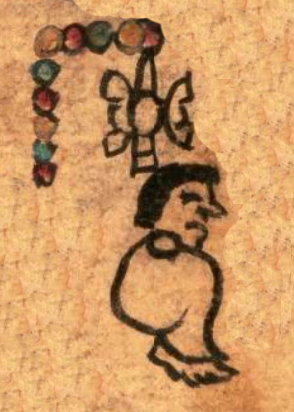Matlactli Olin (CQ)
The combined simplex glyph for movement (Olin) and notation for the number 10 (Matlactli) is a date for a given day from the 260-day divinatory calendar, as deciphered in Nahuatl. For Mesoamericans, calendrics play an important role in their religious view of the cosmos.
In this case, 10-Olin is also the personal name of a ruler who lived in Southern Puebla. The sign for movement looks something like a butterfly, with wings on each side of a central axis (which has the shape of a spine or thorn with a circle in the middle). The overall shape is a quincunx. The notation consists of a row of five vertical circles on the left side, and a row of five horizontal circles across the top. The circles show a pattern in the choice of colors, red, yellow, and turquoise blue, and repeating, if we start from the upper right corner.
Stephanie Wood
The use of coloring for the ones has a significance or purpose awaiting further analysis.
Stephanie Wood
covers ruling men and women of Tecamachalco through 1593
Stephanie Wood
numbers, números, fechas, dates, diez, movimiento, calendarios, tonalpohualli, mahtlactli, nombres de hombres

ol(in), movement, https://nahuatl.wired-humanities.org/content/olin
matlac(tli), ten, https://nahuatl.wired-humanities.org/content/matlactli
Diez Movimiento, 10-Movimiento
Stephanie Wood
The Codex Quetzalecatzin, aka Mapa de Ecatepec-Huitziltepec, Codex Ehecatepec-Huitziltepec, or Charles Ratton Codex. Library of Congress. https://www.loc.gov/item/2017590521/
The Codex Quetzalecatzin, aka Mapa de Ecatepec-Huitziltepec, Codex Ehecatepec-Huitziltepec, or Charles Ratton Codex. Library of Congress. https://www.loc.gov/item/2017590521/



